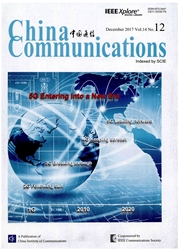

 中文摘要:
中文摘要:
This paper discusses some challenges in the design of millimeter-wave(nunwave) circuits and systems for 5th generation(5G) wireless systems in CMOS process.The properties of some passive and active devices such as inductors,capacitors,transmission lines,transformers and transistors in mm-wave frequency band are discussed.Self-healing technique dealing with PVT variation,resonant mode switching technique to enhance frequency tuning range of voltage controlled oscillator(VCO) and dual mode technique for power amplifier(PA) efficiency enhancement are introduced.At last,A fully-integrated60 GHz 5 Gb/s QPSK transceiver with the transmit/receive(T/R) switch in 65 nm CMOS process is introduced.The measured error vector magnitude(EVM) of the TX is-21.9dB while the bit error rate(BER) of the RX with a-52 dBm sine-wave input is below 8e-7when transmitting/receiving 5 Gb/s data.The transceiver is powered by 1.0 V and 1.2 V supply(except the phase-frequency detector and charge-pump in the frequency synthesizer which are powered by 2.5 V supply) and consumes 135 mW in TX mode and 176 mW in RX mode.
 英文摘要:
英文摘要:
This paper lenges in the design of discusses some chal- millimeter-wave (mln- wave) circuits and systems for 5th generation (5G) wireless systems in CMOS process. The properties of some passive and active devices such as inductors, capacitors, transmission lines, translbrmers and transistors in mm-wave frequency band are discussed. Self-healing technique dealing with PVT variation, res- onant mode switching technique to enhance frequency tuning range of voltage controlled oscillator (VCO) and dual mode technique for power amplifier (PA) efficiency enhancement are introduced. At last, A fully-integrated 60 GHz 5 Gb/s QPSK transceiver with the transmit/receive (T/R) switch in 65nm CMOS process is introduced. The measured error vector magnitude (EVM) of the TX is -21.9 dB while the bit error rate (BER) of the RX with a -52 dBm sine-wave input is below 8e-7 when transmitting/receiving 5 Gb/s data. The transceiver is powered by 1.0 V and 1.2 V supply (except the phase-frequency detector and charge-pump in the frequency synthesizer which are powered by 2.5 V supply) and con- sumes 135 mW in TX mode and 176 mW in RX mode.
 同期刊论文项目
同期刊论文项目
 同项目期刊论文
同项目期刊论文
 An Efficiency-Enhanced Stacked 2.4-GHz CMOS Power Amplifier With Mode Switching Scheme for WLAN Appl
An Efficiency-Enhanced Stacked 2.4-GHz CMOS Power Amplifier With Mode Switching Scheme for WLAN Appl A 5/20MHz BW Reconfigurable Quadrature Bandpass CT Sigma-Delta Modulator with Anti-pole-splitting Op
A 5/20MHz BW Reconfigurable Quadrature Bandpass CT Sigma-Delta Modulator with Anti-pole-splitting Op 期刊信息
期刊信息
